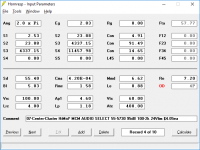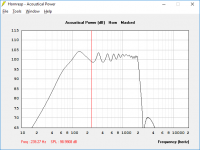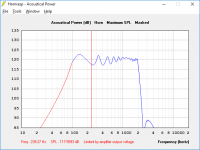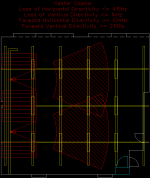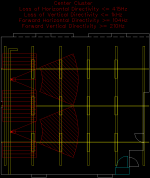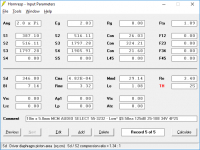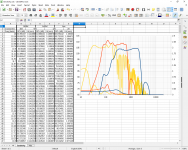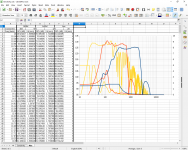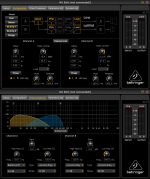Well, I've started designing some internal stuff, focusing on just the main horns so far. I figured I'd start with what I have a spreadsheet for (thanks again, Bill Waslo! https://www.diyaudio.com/forums/members/bwaslo.html ), and continue from there.
I found this for a rear compression driver:
PRV Audio D280Ti-B 1" Titanium Horn Compression Driver 8 Ohm 2/3-Bolt
and 4 of these for upper-midranges:
https://www.newark.com/mcm-audio-select/55-5730/4-woofer-with-foam-surround/dp/95Y2944
Now before anyone points out how cheap these mids are and how they can't possibly sound good, my understanding is that the things that make a speaker expensive make no difference whatsoever in a horn. Excursion-based linearity doesn't matter because they're hardly moving at all. (horns load the driver with pressure, not movement) Cone-flex distortion is stopped by the bandpass enclosure that feeds the horn. Directivity is dictated purely by the horn itself with no regard whatsoever for the drivers' own directivity. So a horn driver like this really is *solely* a piston. Its job is to create pressure in a small space, and that's *all*. It stays well within the magnetic gap, so pretty much any driver can do it linearly, even the cheap ones.
Someone want to check me on that?
Anyway, here's what I came up with for the mids, giving them one channel of a NX1000D (the other channel drives the compression tweeter in BiAmp mode):
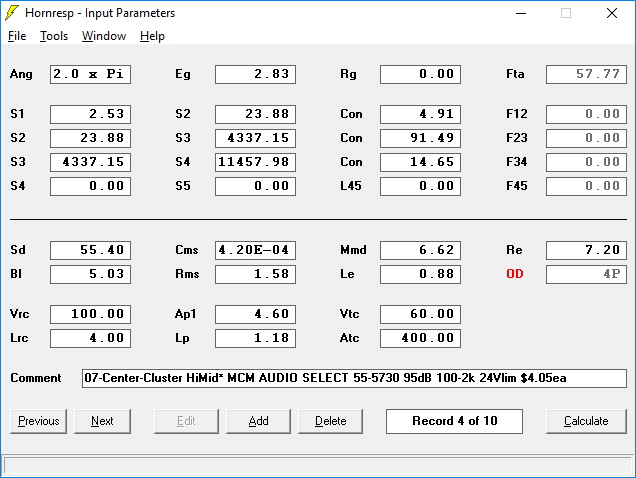
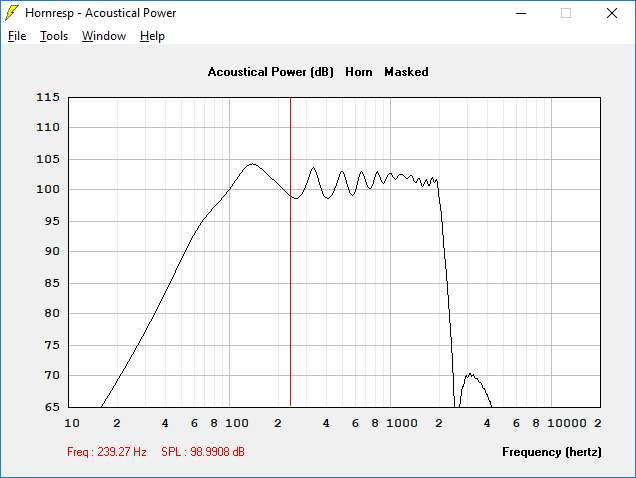
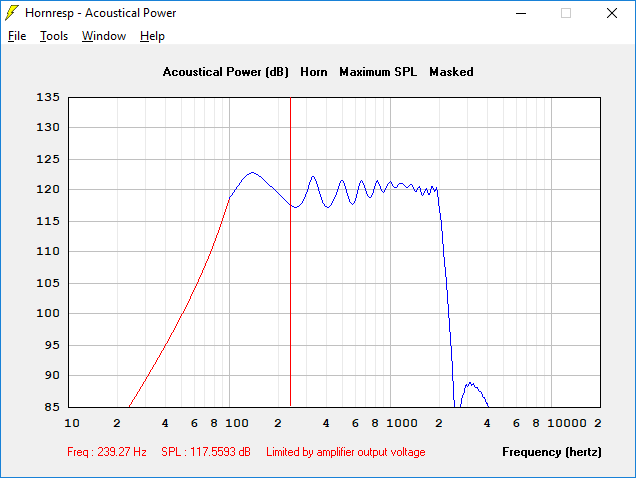
The Maximum SPL is mostly to find a single-number limit for the output voltage. (because the NX****D series can do that) So I put in the amp's full specs to see where the driver is limited, then see what the simulated voltage is to meet that limit. Take the minimum voltage inside the passband, and re-run the max SPL with that instead of the amp's capability. In this case, it's 24V, compared to the NX1000's calculated max of just over 30V (500W into 2ohms), so I think I sized this amp about right for this speaker.
I would like to have had a higher upper cutoff, and the simulation looks like I've done a pretty good job of making the best of what I got, but the "brickwall frequency" depends entirely on the position of the ports from the throat. And because these are 4" drivers, I'm already on the edges to fit them in where they are. I could probably do better with 3" or 2" drivers, but I couldn't find any at this price point. As-is, I'm at 2kHz, and the recommended highpass for the compression driver is 12dB/oct at 1.8k. Playing with the Filter Wizard in HornResp suggests that a 48dB/oct Linkwitz-Riley at 1.8k would hide the sharp drop-off, essentially replacing it with its own. A matching 48dB LR for the CD would cut out more than it needs to, but that's okay.
Sure, I don't *have* to match them, and the Synergy concept on its own certainly doesn't require anything near that aggressive, but it seems like it'd be better to have the filters line up the way that they're designed to, with drivers behaving well enough on either side that it works as if they all go on forever. (using a driver's natural rolloff as part of the filter seems like a waste of headroom to me) Match filters, match delays, match amplitudes, and it becomes impossible to tell where the crossover is, either by listening or by measuring. Thus, the old adage about not having a crossover in the middle of the intelligibility range no longer applies.
So that's the mids. Maybe I can find some smaller drivers and redo them better, but I think I can live with what I've got at the moment.
I found this for a rear compression driver:
PRV Audio D280Ti-B 1" Titanium Horn Compression Driver 8 Ohm 2/3-Bolt
and 4 of these for upper-midranges:
https://www.newark.com/mcm-audio-select/55-5730/4-woofer-with-foam-surround/dp/95Y2944
Now before anyone points out how cheap these mids are and how they can't possibly sound good, my understanding is that the things that make a speaker expensive make no difference whatsoever in a horn. Excursion-based linearity doesn't matter because they're hardly moving at all. (horns load the driver with pressure, not movement) Cone-flex distortion is stopped by the bandpass enclosure that feeds the horn. Directivity is dictated purely by the horn itself with no regard whatsoever for the drivers' own directivity. So a horn driver like this really is *solely* a piston. Its job is to create pressure in a small space, and that's *all*. It stays well within the magnetic gap, so pretty much any driver can do it linearly, even the cheap ones.
Someone want to check me on that?
Anyway, here's what I came up with for the mids, giving them one channel of a NX1000D (the other channel drives the compression tweeter in BiAmp mode):
The Maximum SPL is mostly to find a single-number limit for the output voltage. (because the NX****D series can do that) So I put in the amp's full specs to see where the driver is limited, then see what the simulated voltage is to meet that limit. Take the minimum voltage inside the passband, and re-run the max SPL with that instead of the amp's capability. In this case, it's 24V, compared to the NX1000's calculated max of just over 30V (500W into 2ohms), so I think I sized this amp about right for this speaker.
I would like to have had a higher upper cutoff, and the simulation looks like I've done a pretty good job of making the best of what I got, but the "brickwall frequency" depends entirely on the position of the ports from the throat. And because these are 4" drivers, I'm already on the edges to fit them in where they are. I could probably do better with 3" or 2" drivers, but I couldn't find any at this price point. As-is, I'm at 2kHz, and the recommended highpass for the compression driver is 12dB/oct at 1.8k. Playing with the Filter Wizard in HornResp suggests that a 48dB/oct Linkwitz-Riley at 1.8k would hide the sharp drop-off, essentially replacing it with its own. A matching 48dB LR for the CD would cut out more than it needs to, but that's okay.
Sure, I don't *have* to match them, and the Synergy concept on its own certainly doesn't require anything near that aggressive, but it seems like it'd be better to have the filters line up the way that they're designed to, with drivers behaving well enough on either side that it works as if they all go on forever. (using a driver's natural rolloff as part of the filter seems like a waste of headroom to me) Match filters, match delays, match amplitudes, and it becomes impossible to tell where the crossover is, either by listening or by measuring. Thus, the old adage about not having a crossover in the middle of the intelligibility range no longer applies.
So that's the mids. Maybe I can find some smaller drivers and redo them better, but I think I can live with what I've got at the moment.
Attachments
On to the woofers...those were FUN! 🙄 In fact, I'm wondering now if they'll even exist in the final version. Just leave the main horns as two-ways that cross over to an upper sub around 240Hz-ish. (the red cursor above)
I think I went through 5 different low-mid driver candidates, ranging from 10" to 15", trying to get something that would play well enough below my intended 80Hz lower crossover to hand off smoothly. But no matter what I tried, which driver I used, where I put the ports, or how much rear volume I gave them, the excursion would always explode around 70-80Hz to the point of unusability. (and the SPL would drop off a cliff)
Well, maybe I need a different strategy...what if I ported the back wave into the horn as well, instead of it being a sealed enclosure? That would make it a tapped horn instead of an offset driver, so I went back to my de-facto manual for HornResp ( Hornresp for Dum... hmm... Everyone 😉 - Home Theater Forum and Systems - HomeTheaterShack.com ) and looked up the section on tapped horns. And there just happened to be a reminder note, just mentioned in passing, that the total length of a horn determines its absolute lower cutoff. Hmmm... Okay, before I chase this new rabbit trail of a desperate TH design, what *is* my lower cutoff? Let's see....speed-of-sound...divide-by...total-depth...equals......a bit higher than where I'm having problems, but that's a full wave. It looks suspiciously like 4x my problem though, so divide by 4 to confirm, and...bingo! Exactly where my excursion explodes every time!
(Note to self: Add an absolute minimum frequency figure to my SynergyCalc master copy.)
So...so much for crossing these over at 80Hz then. Have to use something higher, or make a longer horn, which would either expand a mouth that is already the maximum size that I think I can accommodate, or tighten up the coverage. I really like where they sit and what they do at the top end, so I think I'll leave them as they are, drop the supplemental cardioid idea as no longer needed at the higher crossover, and go back to two sets of fully-cardioid subs to try and keep it off of the stage.
I haven't started into the TH designs yet, but with 3 octaves to cover from 30Hz to meet the main horns, I'm thinking to split it into two ranges of 1.5 octaves each: 30-85Hz, and 85-240Hz. A TH by itself would probably cover that entire 3-octave range just fine, but the EQ boost required for a single cardioid array to do that gets to be ridiculous. The drivers are spaced 1/4-wave apart at the maximum frequency, and the converging phase between the constant spacing and the increasing wavelength ends up with a 6dB/oct rolloff that continues as far down as you want to go. +18dB of makeup gain at 30Hz seems a bit much to me. +9dB (1.5 octaves per array) is still pushing it, but it also becomes ridiculous to have a bunch of one-note subs. I think two subs is a good compromise, but with +9dB at the bottom end of each, they'll either have to do that acoustically, or have some pretty high power ratings for what they're doing.
And even so, what about gradient arrays in general not liking boundaries? If you put one next to a wall, the "mirror principle" still applies in the sense of having a mirrored copy on the other side of the wall and the wall not being there. So what does *that* sound like? Well, I would think that having a null at the back wall would still help, even though it's close, because the mirrored null is pointed back into the room. Sure, there'll be some spill because the null is only one point and even that is not perfect, but it's a whole lot better than full volume from that wall! So I'm not entirely sure what the problem is of having a rear null against a wall.
The tradeoff, of course, of having the null on the wall instead of on the floor, is that it's still fairly strong on the floor. That works against the idea of keeping the stage quiet, but I think it's still helped by killing the rear reflection.
And then there's the proximity effect, because of the distance between drivers being significant compared to your distance from them. They won't exactly cancel like the theory says they should (what point is the angle measured from, anyway?), so that'll make them a bit louder too.
Kinda looks like my stage volume is primarily determined by the directivity of the forward driver on its own, and after that, I'm just managing acoustics from the back wall. Below the forward "backswing" frequency, the stage itself still gets it. If I had a bigger room, I might still be able to keep the stage quiet...oh well.
So the space between the main horns is getting crowded again. I'm not sure yet how I'm going to do it, but that 46"H x 36"V area between two 50"H x 36"V tops needs to accommodate two sets of subs now instead of just one. And to keep the same (or comparable) vertical directivity as required to keep the stage quiet, I think the vertical dimension needs to stay the full 36" for at least the upper sub. That would make it fairly narrow, but probably okay? It'd be a big jump in angular horizontal coverage, but looking at the drawing again, there aren't a whole lot of people where that difference would be.
If I can keep it off the stage directly, using its own natural directivity, then the actual cardioid part can be deferred to a lower frequency, and still not reach full strength for a while. I think that'll help everyone out.
I think I went through 5 different low-mid driver candidates, ranging from 10" to 15", trying to get something that would play well enough below my intended 80Hz lower crossover to hand off smoothly. But no matter what I tried, which driver I used, where I put the ports, or how much rear volume I gave them, the excursion would always explode around 70-80Hz to the point of unusability. (and the SPL would drop off a cliff)
Well, maybe I need a different strategy...what if I ported the back wave into the horn as well, instead of it being a sealed enclosure? That would make it a tapped horn instead of an offset driver, so I went back to my de-facto manual for HornResp ( Hornresp for Dum... hmm... Everyone 😉 - Home Theater Forum and Systems - HomeTheaterShack.com ) and looked up the section on tapped horns. And there just happened to be a reminder note, just mentioned in passing, that the total length of a horn determines its absolute lower cutoff. Hmmm... Okay, before I chase this new rabbit trail of a desperate TH design, what *is* my lower cutoff? Let's see....speed-of-sound...divide-by...total-depth...equals......a bit higher than where I'm having problems, but that's a full wave. It looks suspiciously like 4x my problem though, so divide by 4 to confirm, and...bingo! Exactly where my excursion explodes every time!
(Note to self: Add an absolute minimum frequency figure to my SynergyCalc master copy.)
So...so much for crossing these over at 80Hz then. Have to use something higher, or make a longer horn, which would either expand a mouth that is already the maximum size that I think I can accommodate, or tighten up the coverage. I really like where they sit and what they do at the top end, so I think I'll leave them as they are, drop the supplemental cardioid idea as no longer needed at the higher crossover, and go back to two sets of fully-cardioid subs to try and keep it off of the stage.
I haven't started into the TH designs yet, but with 3 octaves to cover from 30Hz to meet the main horns, I'm thinking to split it into two ranges of 1.5 octaves each: 30-85Hz, and 85-240Hz. A TH by itself would probably cover that entire 3-octave range just fine, but the EQ boost required for a single cardioid array to do that gets to be ridiculous. The drivers are spaced 1/4-wave apart at the maximum frequency, and the converging phase between the constant spacing and the increasing wavelength ends up with a 6dB/oct rolloff that continues as far down as you want to go. +18dB of makeup gain at 30Hz seems a bit much to me. +9dB (1.5 octaves per array) is still pushing it, but it also becomes ridiculous to have a bunch of one-note subs. I think two subs is a good compromise, but with +9dB at the bottom end of each, they'll either have to do that acoustically, or have some pretty high power ratings for what they're doing.
And even so, what about gradient arrays in general not liking boundaries? If you put one next to a wall, the "mirror principle" still applies in the sense of having a mirrored copy on the other side of the wall and the wall not being there. So what does *that* sound like? Well, I would think that having a null at the back wall would still help, even though it's close, because the mirrored null is pointed back into the room. Sure, there'll be some spill because the null is only one point and even that is not perfect, but it's a whole lot better than full volume from that wall! So I'm not entirely sure what the problem is of having a rear null against a wall.
The tradeoff, of course, of having the null on the wall instead of on the floor, is that it's still fairly strong on the floor. That works against the idea of keeping the stage quiet, but I think it's still helped by killing the rear reflection.
And then there's the proximity effect, because of the distance between drivers being significant compared to your distance from them. They won't exactly cancel like the theory says they should (what point is the angle measured from, anyway?), so that'll make them a bit louder too.
Kinda looks like my stage volume is primarily determined by the directivity of the forward driver on its own, and after that, I'm just managing acoustics from the back wall. Below the forward "backswing" frequency, the stage itself still gets it. If I had a bigger room, I might still be able to keep the stage quiet...oh well.
So the space between the main horns is getting crowded again. I'm not sure yet how I'm going to do it, but that 46"H x 36"V area between two 50"H x 36"V tops needs to accommodate two sets of subs now instead of just one. And to keep the same (or comparable) vertical directivity as required to keep the stage quiet, I think the vertical dimension needs to stay the full 36" for at least the upper sub. That would make it fairly narrow, but probably okay? It'd be a big jump in angular horizontal coverage, but looking at the drawing again, there aren't a whole lot of people where that difference would be.
If I can keep it off the stage directly, using its own natural directivity, then the actual cardioid part can be deferred to a lower frequency, and still not reach full strength for a while. I think that'll help everyone out.
I finally have a complete design. Everything works in theory: each frequency range simulates well in Hornresp, AND they all fit in the space together! 😀
Looking at 125dB max @ 1m across the board, down to an honest 30Hz, for about $1400 worth of electronics. (not sure how much the paneling is going to be yet)
Here's the top view:
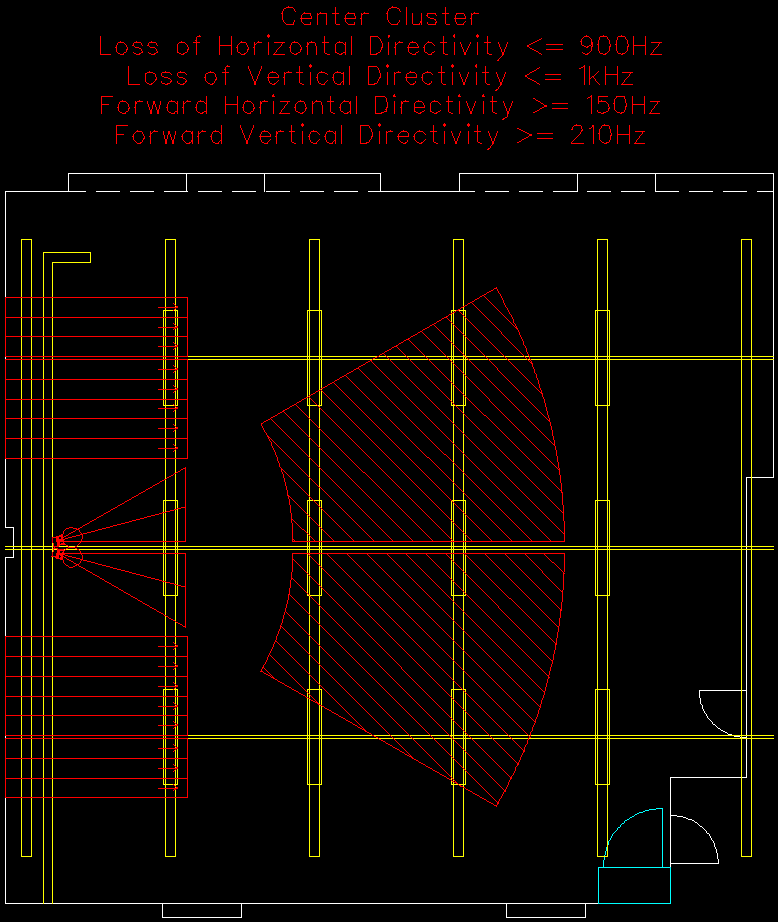
I moved the main horns again, this time to the center, and tightened them up to keep them off of the walls again. From 45degH x 30degV to 30degSquare for each.
Subs are arrayed out to the sides. 8x 10" each side for those, with 2 drivers per unit for that much more piston area. (total of 16 10" drivers per side, all playing 30Hz to 120Hz - turns out that's one of the cheapest drivers per volumetric displacement, so there we go)
And a side view:
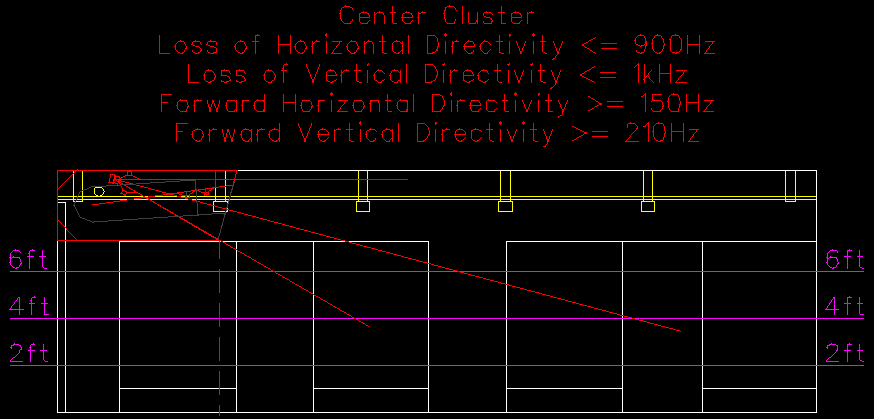
Here you can see that the main horns are still the same Synergy-clone concept, and the subs are single-fold TH's that take up the entire space available to them. Even so, I could just barely make them long enough to hit a solid 30Hz. The dark gray line is the path for the estimated horn length, using 45deg line segments instead of a circular arc as suggested by a few other threads.
I know I'm intersecting the rafters and the drain pipe like a naive CAD artist. I asked our woodsmith about that - if he can wrap a panel around them and seal the gaps again - and he said that he could. It wouldn't be easy, but he could. So I'm relying on that to make an unobstructed front face to project lyrics and videos on (stretch a white cloth over the mouth), and to make the sub horns long enough to work.
The front row of bulk fluorescent lighting is toast too, but we're thinking about something else for the stage anyway.
Some more miscellaneous information:
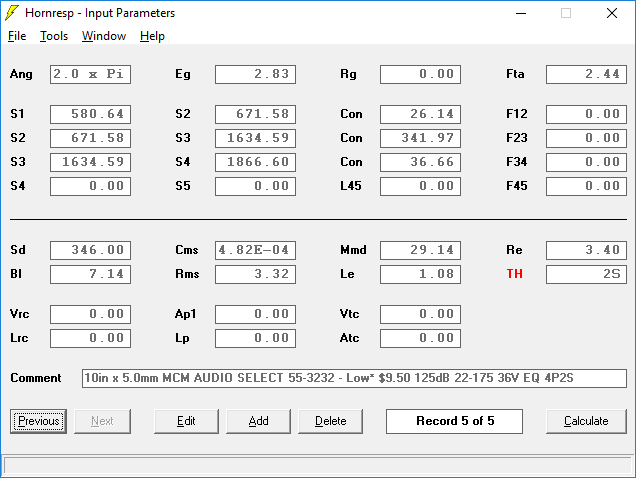
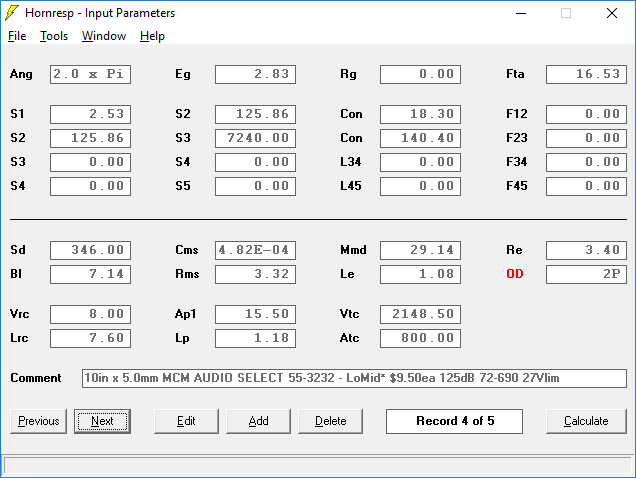
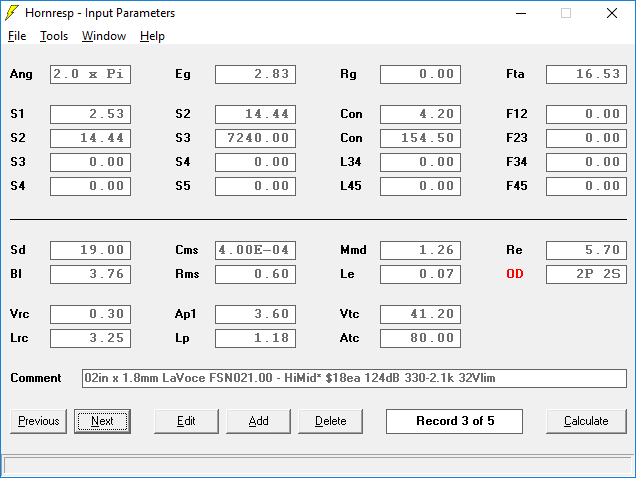
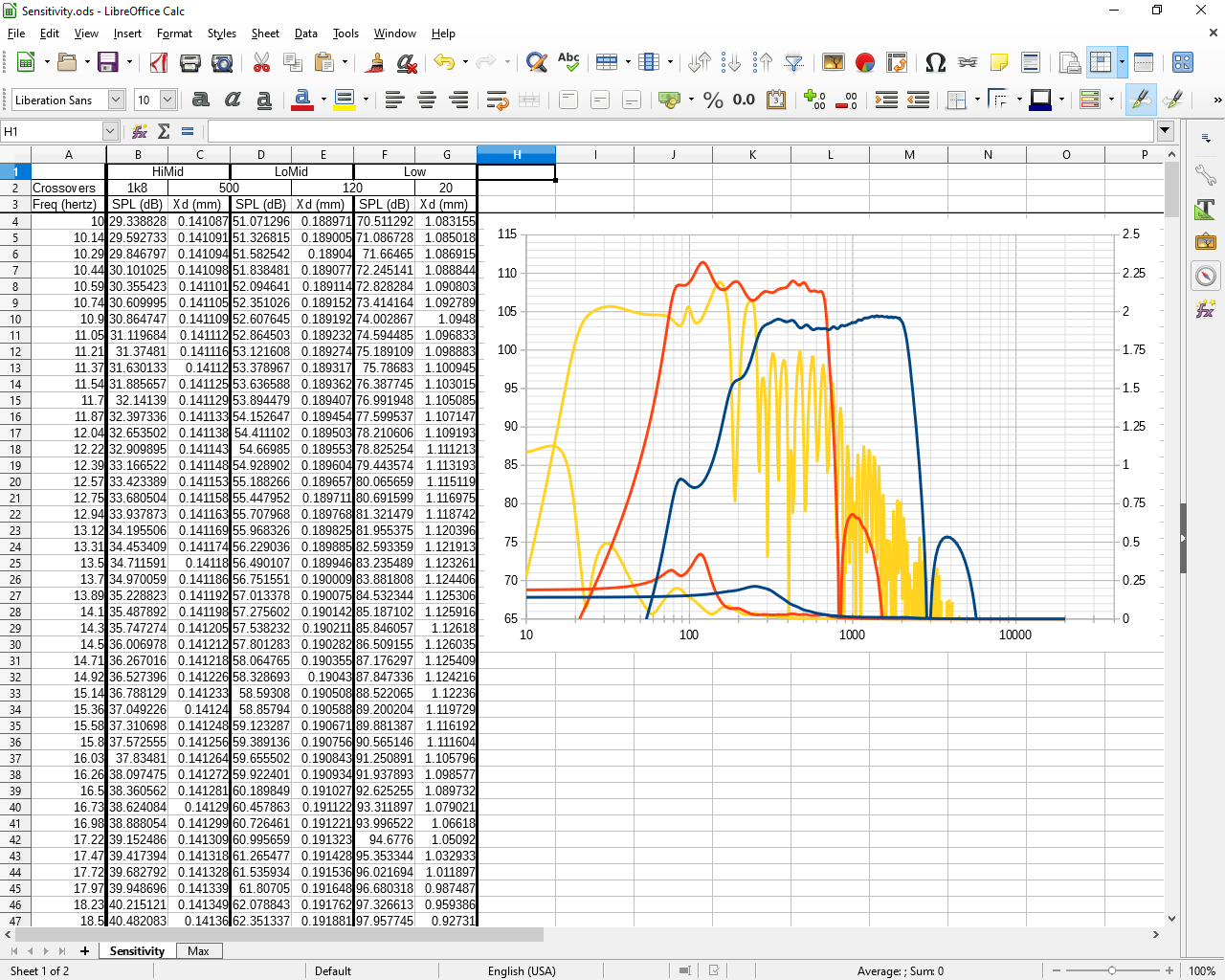
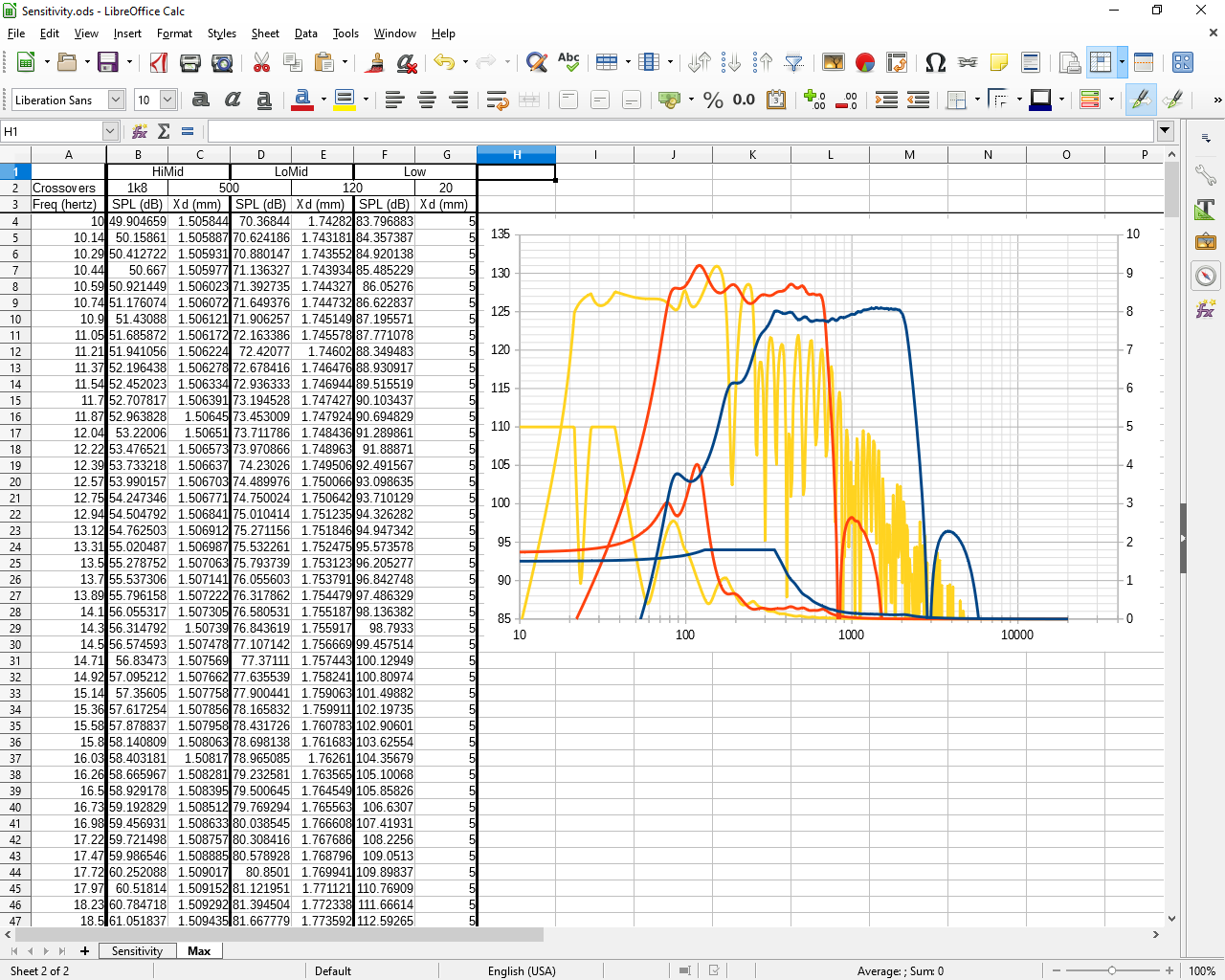
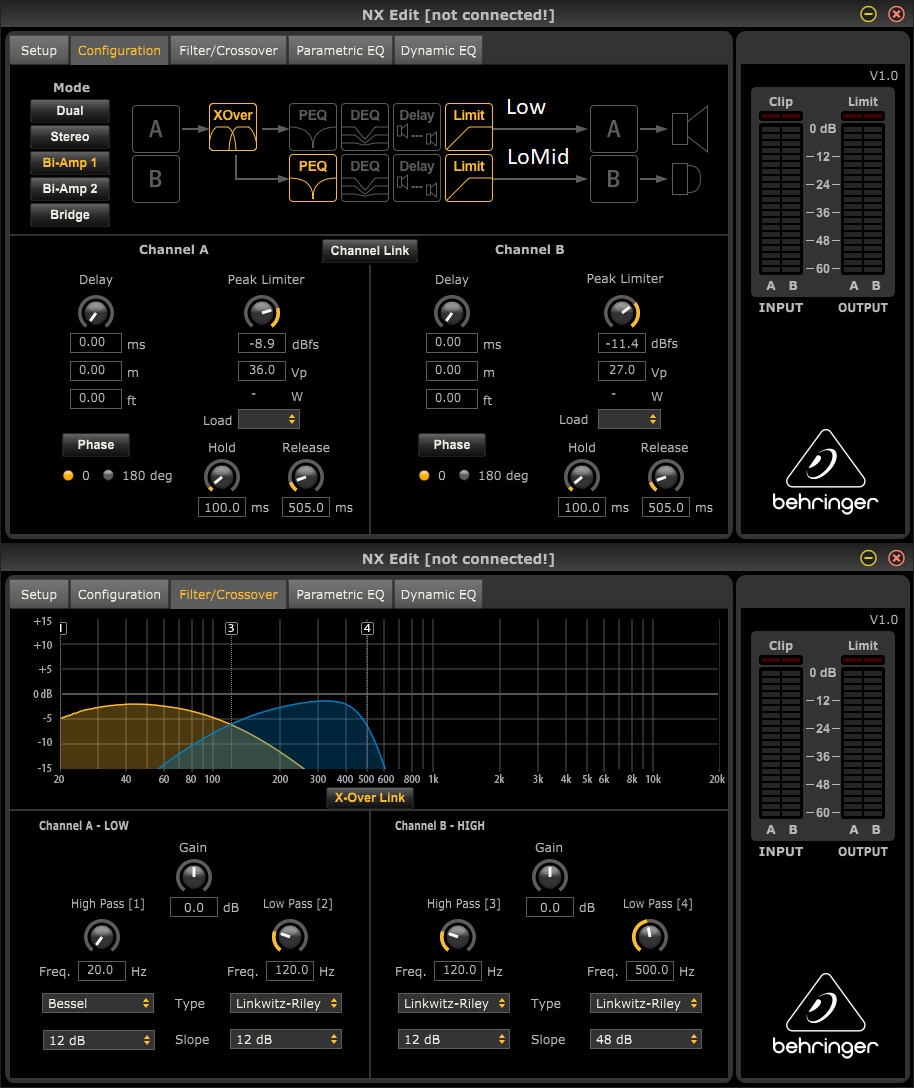
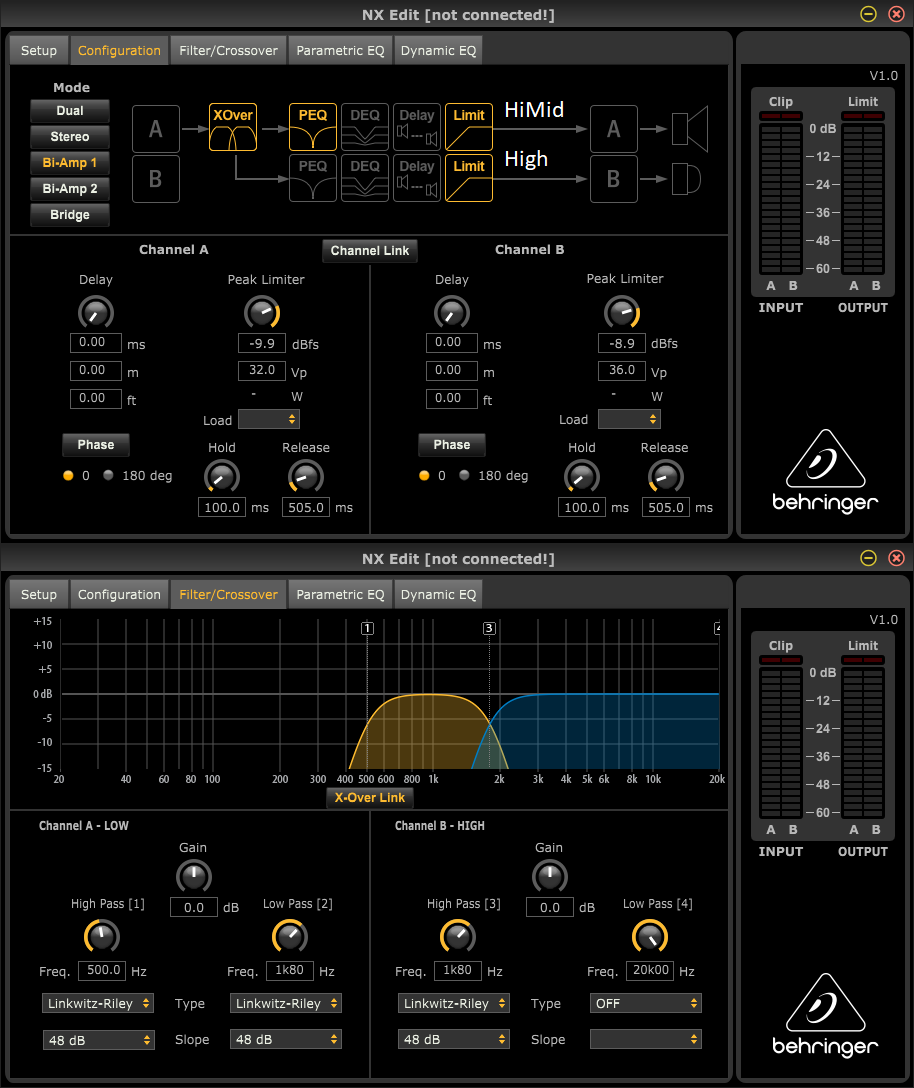
You can see from the 36V limits that the NX1000D will work for everything, so that's nice too.
So now I guess I need to sell this thing. Estimated $2k and a lot of in-house shop work for an estimated $10k worth of quality after tuning?
(It's hard to find any kind of pricing at all in that range. Lots of dealer-protection, so you end up socially committing before you have any idea what it'll cost you.)
Anyone have any thoughts or comments before I do that?
Looking at 125dB max @ 1m across the board, down to an honest 30Hz, for about $1400 worth of electronics. (not sure how much the paneling is going to be yet)
Here's the top view:
I moved the main horns again, this time to the center, and tightened them up to keep them off of the walls again. From 45degH x 30degV to 30degSquare for each.
Subs are arrayed out to the sides. 8x 10" each side for those, with 2 drivers per unit for that much more piston area. (total of 16 10" drivers per side, all playing 30Hz to 120Hz - turns out that's one of the cheapest drivers per volumetric displacement, so there we go)
And a side view:
Here you can see that the main horns are still the same Synergy-clone concept, and the subs are single-fold TH's that take up the entire space available to them. Even so, I could just barely make them long enough to hit a solid 30Hz. The dark gray line is the path for the estimated horn length, using 45deg line segments instead of a circular arc as suggested by a few other threads.
I know I'm intersecting the rafters and the drain pipe like a naive CAD artist. I asked our woodsmith about that - if he can wrap a panel around them and seal the gaps again - and he said that he could. It wouldn't be easy, but he could. So I'm relying on that to make an unobstructed front face to project lyrics and videos on (stretch a white cloth over the mouth), and to make the sub horns long enough to work.
The front row of bulk fluorescent lighting is toast too, but we're thinking about something else for the stage anyway.
Some more miscellaneous information:
You can see from the 36V limits that the NX1000D will work for everything, so that's nice too.
So now I guess I need to sell this thing. Estimated $2k and a lot of in-house shop work for an estimated $10k worth of quality after tuning?
(It's hard to find any kind of pricing at all in that range. Lots of dealer-protection, so you end up socially committing before you have any idea what it'll cost you.)
Anyone have any thoughts or comments before I do that?
Attachments
-
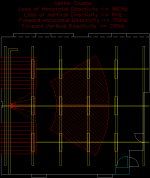 CAD_03_Plan.png19.3 KB · Views: 190
CAD_03_Plan.png19.3 KB · Views: 190 -
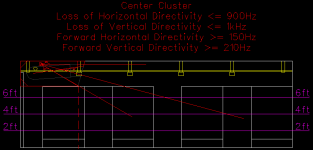 CAD_02_Elevation_South.png9.2 KB · Views: 178
CAD_02_Elevation_South.png9.2 KB · Views: 178 -
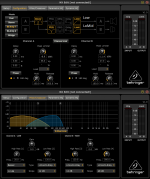 Settings_Lo-LoMid.png125.3 KB · Views: 208
Settings_Lo-LoMid.png125.3 KB · Views: 208 -
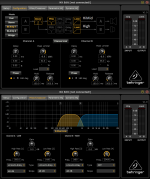 Settings_Hi-HiMid.png124.7 KB · Views: 183
Settings_Hi-HiMid.png124.7 KB · Views: 183 -
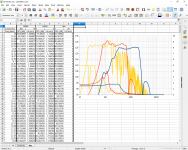 Resp_Max.png237.7 KB · Views: 208
Resp_Max.png237.7 KB · Views: 208 -
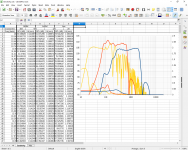 Resp_Sensitivity.png238.5 KB · Views: 194
Resp_Sensitivity.png238.5 KB · Views: 194 -
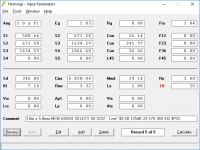 Hornresp_Low.png11.8 KB · Views: 193
Hornresp_Low.png11.8 KB · Views: 193 -
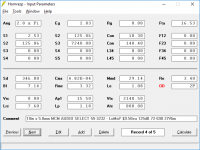 Hornresp_LoMid.png11.5 KB · Views: 174
Hornresp_LoMid.png11.5 KB · Views: 174 -
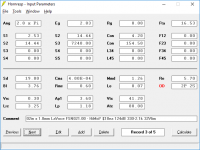 Hornresp_HiMid.png14 KB · Views: 183
Hornresp_HiMid.png14 KB · Views: 183
I was in an open air environment yesterday - a farmer's market (Hawaii). A guy playing slack key guitar and singing in a covered but open-air pavilion, guessing 40 X 75 feet. One portable sound system/speaker. Loud enough to be heard but not ear piercing, so that patrons could speak with vendors and with each other. Good intelligibility. Maybe sound quality could have been better - more frequency extension, but basically acceptable. If this had been a concert, better quality system would be needed but by this I mean less solid state-style distortion and greater frequency extension.
VolunteerSoundGuy
have you considered room gain and the Rt constant of the room in your planning?
have you considered room gain and the Rt constant of the room in your planning?
I was in an open air environment yesterday - a farmer's market (Hawaii). A guy playing slack key guitar and singing in a covered but open-air pavilion, guessing 40 X 75 feet. One portable sound system/speaker. Loud enough to be heard but not ear piercing, so that patrons could speak with vendors and with each other. Good intelligibility. Maybe sound quality could have been better - more frequency extension, but basically acceptable. If this had been a concert, better quality system would be needed but by this I mean less solid state-style distortion and greater frequency extension.
Sounds like a pretty good solution for that application, but not quite for ours. The key phrase for me was, "so that patrons could speak with vendors and with each other." In a market, where this guy was more like a side-show entertainer, it's practically a requirement to not interfere with conversations that are fairly close to him.
For us, though, I want to be capable of drowning out the bad singer that's standing next to me. I've heard several people say independently that they want that, so that they can sing without anyone else hearing them either.
Of course, we won't *always* use that capability, but I do want it to be there.
VolunteerSoundGuy
have you considered room gain and the Rt constant of the room in your planning?
Briefly, yes, but my philosophy tends to decouple the room acoustics from the PA itself. Fundamentally, you can't EQ a room. You can EQ the electronics that drive the room, but you can't EQ the room. The primary problem in the room is not amplitude, but time.
Our ears are very good at picking out the original sound from the reverberant field, so that we consciously hear one but not the other. So the one that we consciously hear (the direct sound) should be tuned "right", while the rest simply does what it does, which is to provide some environmental context of where we are.
So if the PA is tuned outside and then brought in with no changes, it has the best chance of being "right".
Or if it must be tuned inside, you need to take great care in biasing the measurement mic(s) as far as you can away from the reverberant sound and towards the direct sound. You can do this both with placement and with the choice of test signals, so that the reverb doesn't build up in the first place.
So yes, the room will make some difference, and the final tuning will be by ear, with music, after the installation. But the initial baseline, what the DSP amps will be set for, is mostly-flat anechoic. (I'm not going to worry about small ripples; the solution there is worse than the problem.) The final tuning will be in the master EQ of the digital mixer that drives it.
And I'm going to push for acoustic treatment as well. Bass traps/resonators disguised as the barnwood wall that I've heard mentioned for the stage, a fuzzy back wall behind the audience, curtains on the windows instead of blinds, etc.
VolunteerSoundGuy;5731566]Sounds like a pretty good solution for that application, but not quite for ours. The key phrase for me was, "so that patrons could speak with vendors and with each other." In a market, where this guy was more like a side-show entertainer, it's practically a requirement to not interfere with conversations that are fairly close to him.
For us, though, I want to be capable of drowning out the bad singer that's standing next to me. I've heard several people say independently that they want that, so that they can sing without anyone else hearing them either.
Of course, we won't *always* use that capability, but I do want it to be there.
>>>>>>>>>
Yes, I understand. I was relating that experience to provide perspective that not all applications require gobs of power, even in a physical environment (outside, large area) that would otherwise suggest the need for it. From your earlier postings, I understand the need for relatively high volume as part of the church service.
For us, though, I want to be capable of drowning out the bad singer that's standing next to me. I've heard several people say independently that they want that, so that they can sing without anyone else hearing them either.
Of course, we won't *always* use that capability, but I do want it to be there.
>>>>>>>>>
Yes, I understand. I was relating that experience to provide perspective that not all applications require gobs of power, even in a physical environment (outside, large area) that would otherwise suggest the need for it. From your earlier postings, I understand the need for relatively high volume as part of the church service.
I want to be capable of drowning out the bad singer that's standing next to me.
Of course, we won't *always* use that capability, but I do want it to be there.
ever think the "bad singer" is just a guy trying to make a few extra bucks doing a gig at a local pub.
you need to get some of this for yourself 3D printed spiral sound killer
ever think the "bad singer" is just a guy trying to make a few extra bucks doing a gig at a local pub.
I'm not sure what you mean by this. We're not a pub, so if someone thinks that, he's in the wrong place. 🙂 (although the shed out back on this newly donated property was apparently a speakeasy in the '30's) Our "bad singers" know (or at least believe) that the sound they produce is not very pleasing to others, but they still want to sing. So they want the music loud enough that they can sing without others hearing them, and they measure that by them not hearing their neighbors.
you need to get some of this for yourself 3D printed spiral sound killer
I've seen that before. It looks like a resonant design, that is, it works well for the designed single frequency, and not so much elsewhere. Hardly a solution to anything remotely like music. Industrial applications, sure, where the sound is consistent, but not music. (unless, of course, you want a one-note hole, like a single notch of a comb filter)
Just minor tweaks now. I didn't like the holes in the front corners, and the solutions to fill them without messing up the rest of the room were getting complicated. So I went back to the quasi-stereo setup where each main horn runs straight back through the center of its assigned coverage area and eventually creates a small stereo image towards the back of the room. I think I can live with that coverage pattern from just the two mains:
Sitting (for a sermon):
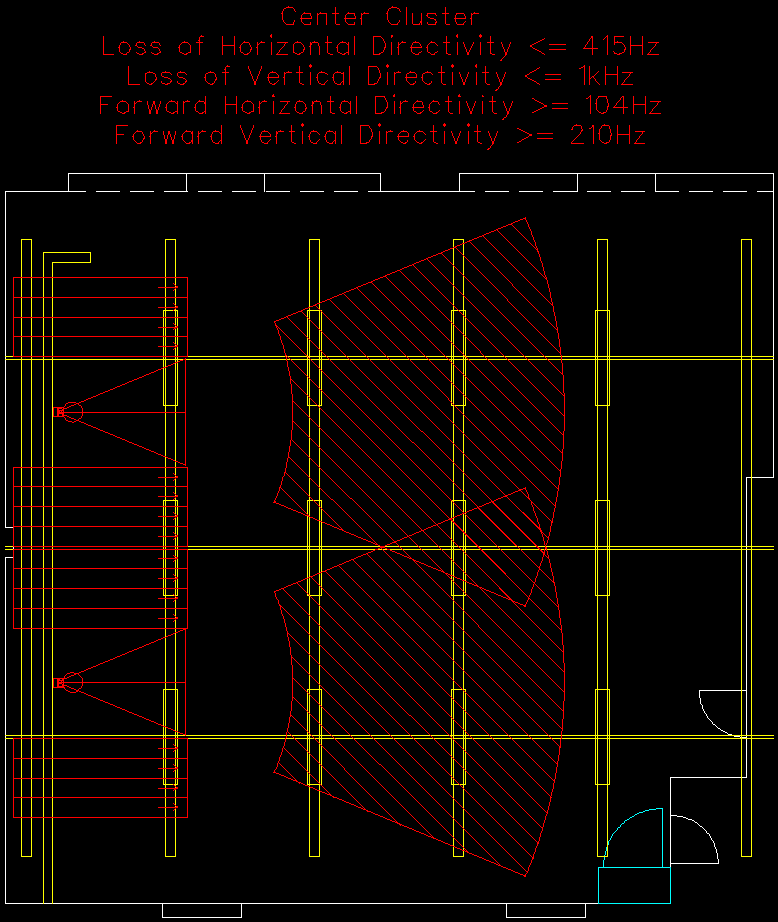
Standing (for music):
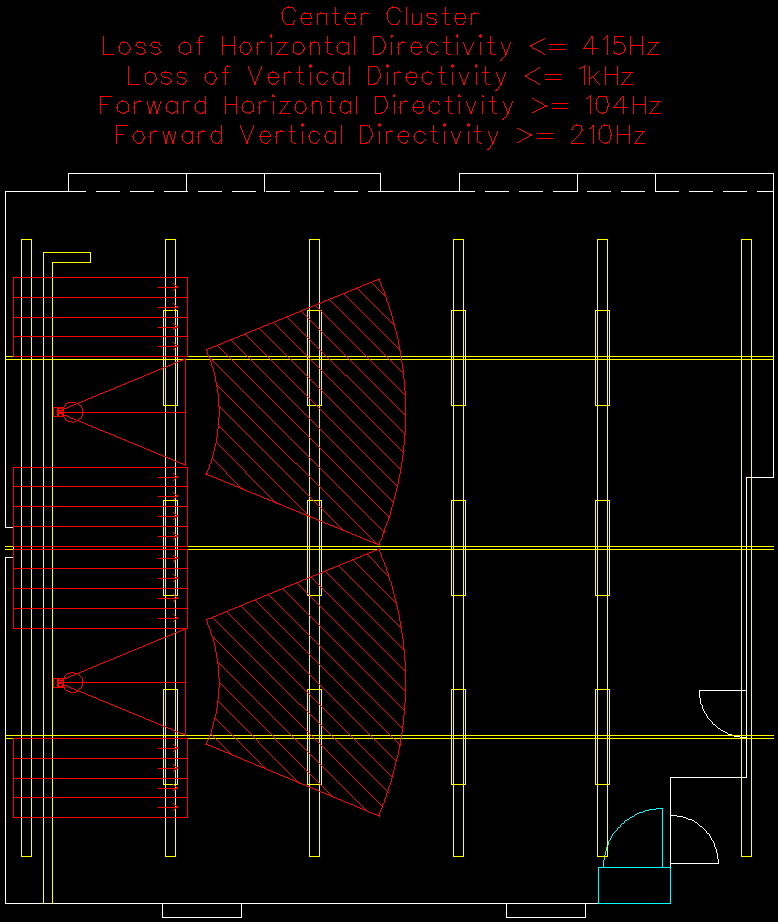
As you can see, that also required the subs to move around, so they're about 4 inches shorter now to clear the bump in the wall. (8" shorter path length) A bit more tweaking there - bigger mouth, smaller throat - and I think I can live with their simulated response too:
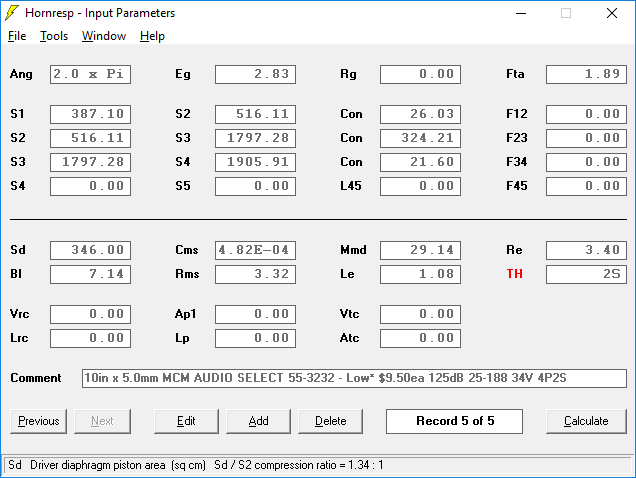
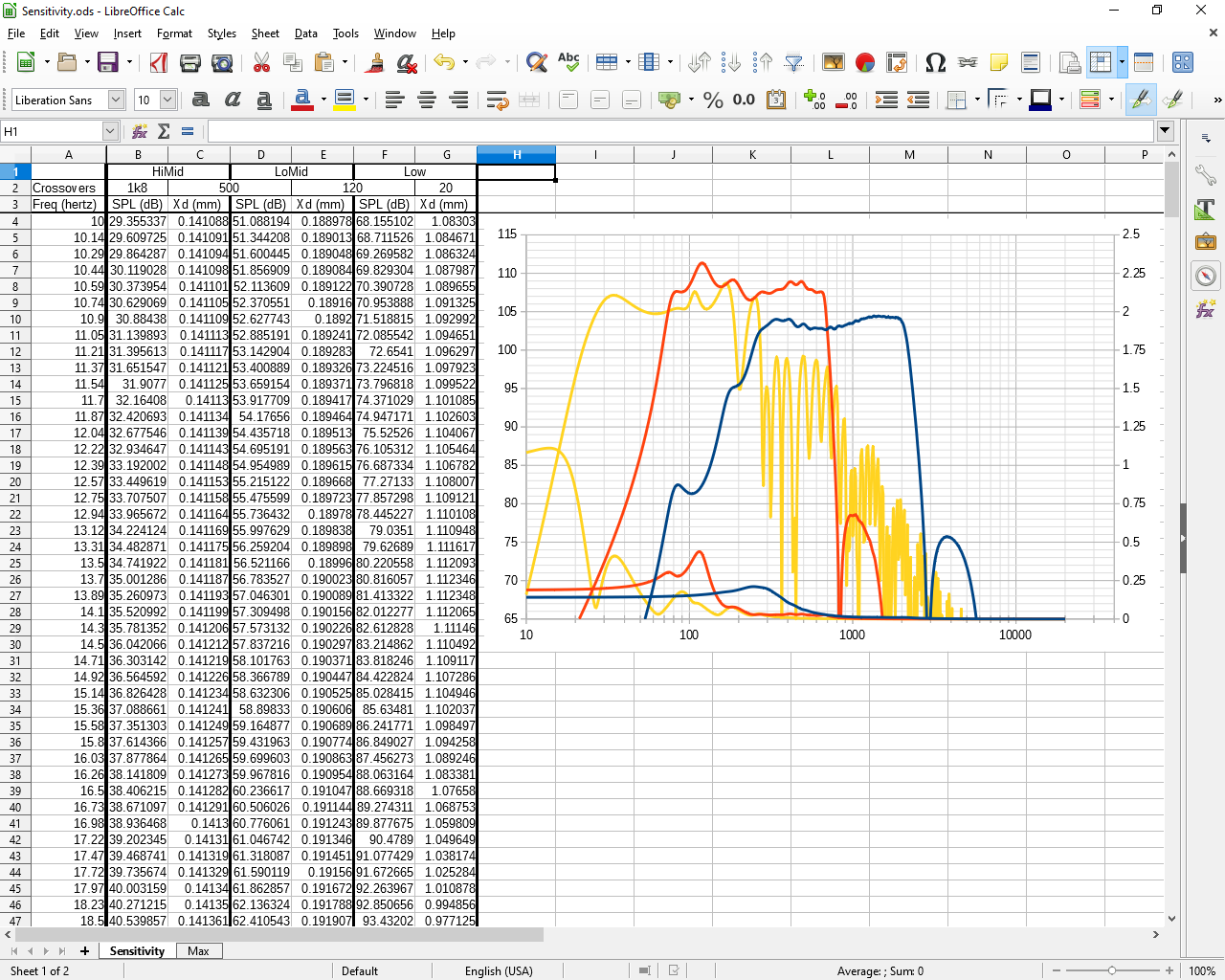
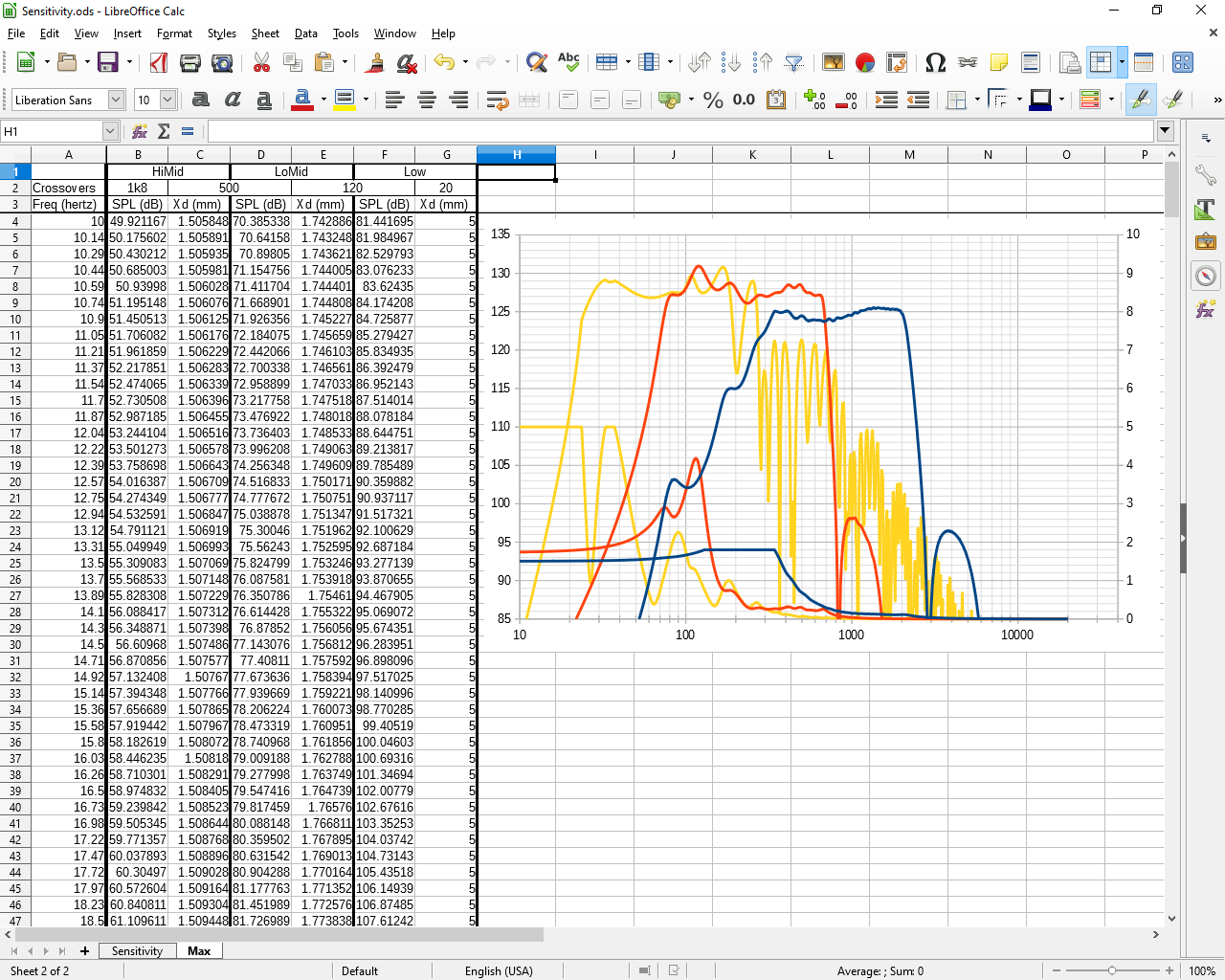
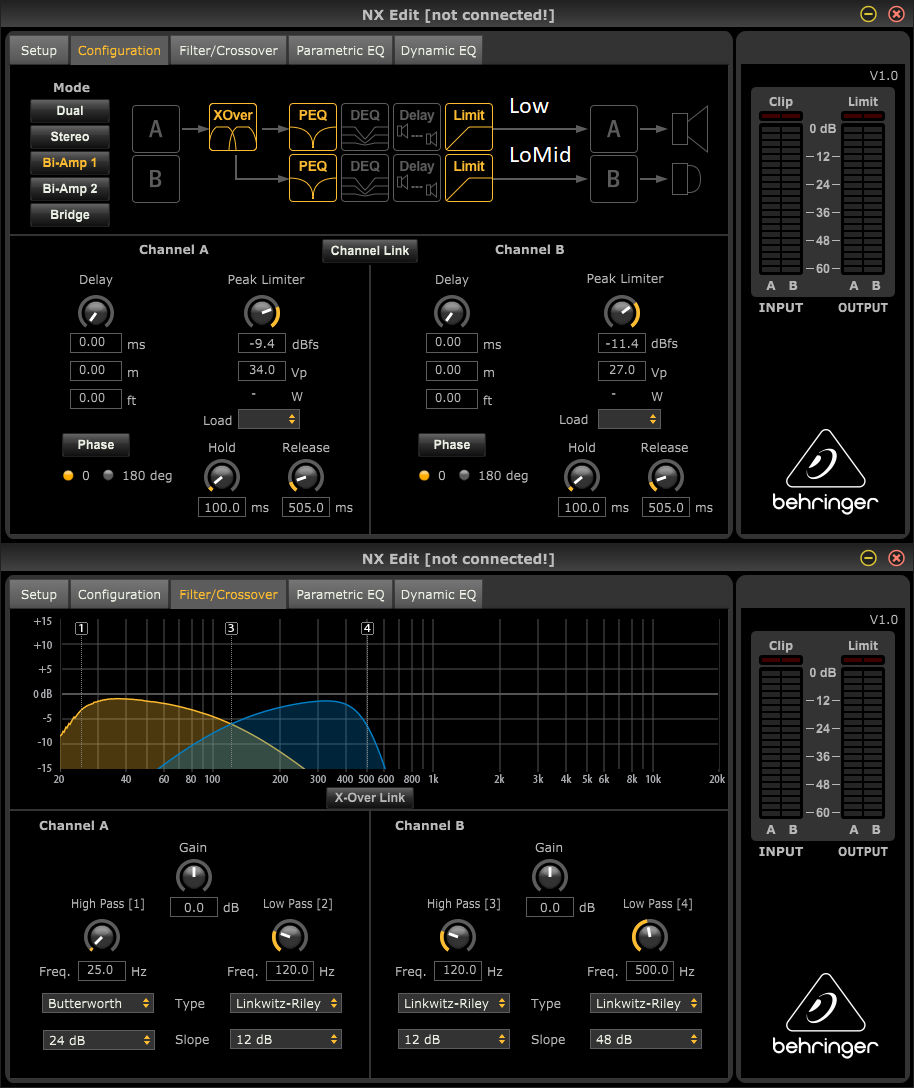
Sitting (for a sermon):
Standing (for music):
As you can see, that also required the subs to move around, so they're about 4 inches shorter now to clear the bump in the wall. (8" shorter path length) A bit more tweaking there - bigger mouth, smaller throat - and I think I can live with their simulated response too:
Attachments
- Status
- Not open for further replies.
- Home
- Live Sound
- PA Systems
- Sanity Check - Custom Installed PA for Small Room
